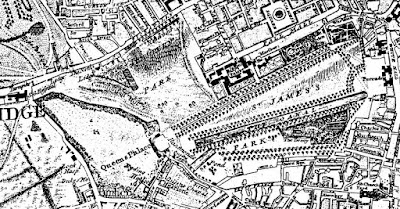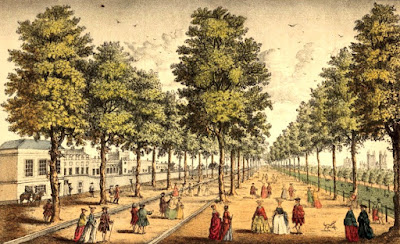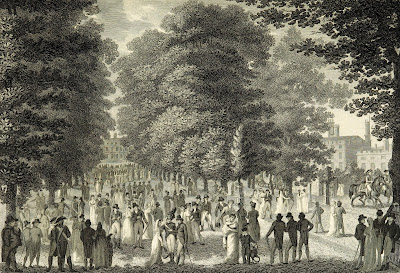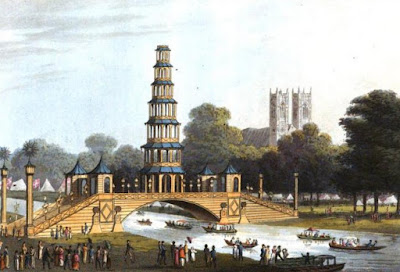St James’s Park is the oldest royal park in London, with St James’s Palace to the north and Buckingham Palace to the west.
The Picture of London for 1810 said:
St James’s Palace and Park are situated near the western extremity of the town, on the side next the river, from which, at a small distance, it is separated by Parliament-street, and the site of Whitehall Palace.1
 |
| Rocque's Map of London of 1741-5 showing St James's Park in London in the Eighteenth Century by Sir Walter Besant (1902) |
After the Restoration of the monarchy in 1660, Charles II redesigned the park. The Picture of London for 1810 wrote:
King Charles II … planted the avenues, made the Canal and the Aviary adjacent to the Bird-cage Walk, which took its name from the cages hung in the trees; but the present fine effect of the small spot of ground within the railing is the fruit of the genius of the celebrated Mr Brown.2
The Mall
Old and New London wrote:
St James's Park must have been a rural and pleasant enclosure in the reign of Charles II, when the avenues of trees were first planted along the northern side of the park, where now is the gravel walk known as ‘The Mall’, under the direction of Le Notre, the French landscape gardener, who was also commissioned to lay out and improve the whole.3
 |
| Royal Palace of St James's next the park from The story of the London Parks by J Larwood (1874) |
Under date of April 2, 1661, there is an entry in Pepys' ‘Diary’ which implies that the ‘Pell Mell’ was then newly finished: “To St James's Park, where I saw the Duke of York playing at Pellmell, the first time that ever I saw the sport.”4
The milk fair
At the end of the Mall, in the shade of the tall trees, near the Spring Gardens entrance, is an ‘institution’ – if we may so call it – of considerable date, and a proof of the former rural character of the spot, which has flourished here perhaps almost since the formation of the Mall. It is known as ‘Milk Fair’, and is held by a privilege granted form royalty to the gatekeepers.5
The canal stretched the whole length of St James’s Park. The Microcosm of London wrote that St James’s Park:
… was very much improved by Charles II who added to it several fields, planted it with rows of lime trees, laid out the Mall (which is a vista nearly half a mile in length), and formed the canal, which is 100 feet broad and 2,800 feet long.6
The Picture of London for 1810 said:
In time of frost, the Canal in St James's park, and the Serpentine River in Hyde-park, are covered with skaiters; here a stranger will find much amusement.7
The duck decoy and Duck Island
According to the Royal Parks website, there have been pelicans living in St James’s Park since the time of Charles II, who was given some pelicans as a gift from the Russian Ambassador.
 |
| The pelicans in St James's Park |
Old and New London wrote:
Close by, at the west end of the water, which was in those days straight, and generally known as the ‘Canal’, was a small decoy and an island, called ‘Duck Island’.
The ‘decoy’ … consisted of five or six straight pieces of water all running parallel to each other and to the canal itself, with which they communicated by narrow openings.8
By 1790, Charles II’s Duck Island had disappeared.
Birdcage Walk
Old and New London wrote:
The birds, which were among the most innocent toys and amusements of the ‘merry monarch’, were kept in aviaries ranged in order along the road which bounds the south side of the Park, and extends to Buckingham Palace, and which is still known by the significative name of ‘Birdcage Walk’.9
Rosamond’s Pond
In the south-west corner, near Birdcage Walk, and opposite to James Street and Buckingham Gate, was formerly a small sheet of water, known as ‘Rosamond's Pond’, to which reference is constantly made in the comedies of the time as a place of assignation for married ladies with fashionable roués … It was filled up in 1770, soon after the purchase of Buckingham House.10
 |
| Rosamond's Pond, St James's Park, in 1758 from Old and New London by E Walford (1878) |
The Horse Guards was built at the eastern extremity of St James’s Park. The Microcosm of London wrote:
The building of the Horse Guards began in the year 1751, and was very expeditiously completed. It is certainly a neat and compact piece of architecture, and appears to the greatest advantage when viewed at a distance, from the park.
The noble edifice of the Horse Guards stands upon part of the site of the vast palace of Whitehall, occupying that spot which was formerly the Tilt-yard; a place set apart by Henry VIII and afterwards by Elizabeth, for military exercises.
In the center is an arched way into St James's Park, the building over which has a pediment, with the king's arms in bass-relief.
That part of St James's Park immediately behind the building, is the parade, and is so called from being the place where the reliefs for the different guards about the palace are every morning paraded and inspected.11
Crosby wrote in A View of London (1802-3) that in April and May:
Every morning, about ten o’clock, a pleasing military spectacle is to be seen in the parade, in the rear of the Horse Guards, St James’s Park, in the change of the guard. A detachment proceeds from thence, in military pomp, to the square of St James’s Palace, where the guard is changed, and a stranger will be entertained with a charming concert of martial music.12
 |
| Mounting guard, St James's Park from The Microcosm of London by R Ackermann and W Combe (1808-10) |
On the north side of the parade is placed a Turkish piece of Ordnance of uncommon length, which was brought from Alexandria in Egypt, by the British army. It is mounted on a carriage of English construction, and is ornamented with several appropriate Egyptian devices, executed with great taste.13
During the Gordon Riots of 1780, the park was used as a military base:
The park, in 1780, was occupied as a camp by several regiments of militia, during the alarm and panic caused by the Gordon riots.14
In 1852, the extensive funeral procession for the Duke of Wellington formed on Horse Guards Parade:
Upon the Parade was marshalled the state funeral procession of the great Duke of Wellington, on the 18th of November, 1852. The body was removed from Chelsea Hospital on the previous midnight, and deposited in the audience-chamber at the Horse Guards. Beneath a tent erected on the parade-ground was stationed the funeral car, whereon the coffin being placed, and the command given, the cortége, in a slow and solemn manner, moved down the Mall, past Buckingham Palace, whence the procession was seen by Her Majesty and the Royal Family, before it made its way to St Paul's.15
The Picture of London for 1813 wrote:
The whole of the northern side of St James’s Park, and the western extremity, are very pleasing to the eye; it is of an oblong form, and nearly two miles in circuit. The eastern extremity is occupied by the Horse-guards, the Treasury, and other edifices, that do not produce an ill effect. But the south side, in which is the Bird-cage Walk, is deplorable in its appearance. There is a species of barracks in that quarter, and a general air of misery and meanness, that should be removed, or obscured by planting. One nuisance disgraces the queen’s palace; it is the small guard-room, lately erected on the south side of the house, near Buckingham-gate.16
 |
| Queen's Palace from The Microcosm of London by R Ackermann and W Combe (1808-10) |
In summer, the avenues on the northern side of St James’s park form a favourite promenade for the inhabitants of the metropolis; which, in fine weather, on Sundays in the afternoon and evening, is always extremely crowded with well-dressed company. But, though a favourite, this is not a very fashionable walk, people of rank preferring Kensington gardens and the Green-park.17
 |
| Promenade in St James's Park from Modern London by R Phillips (1804) |
On 1 August 1814, there were huge celebrations in London to celebrate 100 years of the Hanoverian Succession and peace (albeit temporary) with France. A grand Chinese bridge was built across the canal in St James’s Park, topped with a magnificent pagoda, covered with fireworks for a grand firework display. Old and New London wrote that:
… an official programme was issued, in which the public were informed that a beautiful Chinese bridge had been thrown over the canal, upon the centre of which had been constructed an elegant and lofty pagoda, consisting of seven pyramidal storeys. ‘The pagoda to be illuminated with gas lights; and brilliant fireworks, both fixed and missile, to be displayed from every division of the lofty Chinese structure.’18
Unfortunately, the pagoda caught fire and was destroyed, but the Chinese bridge survived until 1825. According to Orme's An Historical Memento:
At length, about midnight, while the last discharges of artillery were firing, and many hundreds of persons were leaving the Parks, their attention was arrested by a lamentable accident. The pagoda exhibited an appearance that excited much doubt. Its upper towers seemed enveloped in flame; and it was soon learned, that it had actually caught fire by some accident in the management of the machinery. The fire increased rapidly. Several engines were procured, and played upon it; but it continued burning, till, in a short time, the five upper towers were destroyed, or fell over the eastern side of the bridge: the lower ones were in a state little better, and some part of the substructure was much deteriorated. There was a kind of awful magnificence during the progress of the flames, that exceeded the former appearance of the edifice; but, at last, it presented only the melancholy remains of temporary splendour.19
 |
| Chinese Bridge and Pagoda, St James's Park, in 1814 from An Historical Memento by E Orme (1814) |
 |
| Chinese Bridge and Pagoda illuminated, St James's Park, on 1 August 1814 from An Historical Memento by E Orme (1814) |
During the 1820s, George IV commissioned John Nash to remodel St James’s Park. Nash transformed the canal into a more natural looking lake, created a processional route down the Mall, and built a huge marble arch at the entrance to Buckingham Palace. Old and New London wrote:
The most beautiful parts of St James's Park are the walks beside the Ornamental Water, which is still called ‘the canal’, in memory of its former unsightly shape. The water is alive with waterfowl, for whose comfort and protection a quiet and secluded island, with the Swiss cottage of the Ornithological Society, is reserved, at the southeastern extremity, nearly on the site of the old ‘decoy’.20
According to Old and New London, the ‘Swiss cottage’ was erected in 1841. The Marble Arch was moved to the intersection of Oxford Street and Park Lane in 1851.
 |
| Buckingham Palace and St James's Park from Illustrated London by WI Bicknell (1847) |
St James’s Park today
Rachel Knowles writes clean/Christian Regency era romance and historical non-fiction. She has been sharing her research on this blog since 2011. Rachel lives in the beautiful Georgian seaside town of Weymouth, Dorset, on the south coast of England, with her husband, Andrew.
Find out more about Rachel's books and sign up for her newsletter here.If you have enjoyed this blog and want to encourage me and help me to keep making my research freely available, please buy me a virtual cup of coffee by clicking the button below.
Notes
(1) Feltham, John, The Picture of London for 1810 (1810).
(2) Ibid.
(3) Walford, Edward, Old and New London: A narrative of its history, its people, and its places (Cassell, Petter & Galpin, 1878, London) Vol 5.
(4) Ibid.
(5) Ibid.
(6) Ackermann, Rudolph and Pyne, William Henry, The Microcosm of London or London in miniature Volume 2 (Rudolph Ackermann 1808-1810, reprinted 1904).
(7) Feltham op cit.
(8) Walford op cit.
(9) Walford op cit.
(10) Walford op cit.
(11) Ackermann and Pyne op cit.
(12) Crosby, B, A View of London; or the Stranger's Guide through the British Metropolis (Printed for B Crosby, London, 1803-4).
(13) Feltham op cit.
(14) Walford op cit.
(15) Walford op cit.
(16) Feltham, John, The Picture of London for 1813 (1813).
(17) Phillips, Richard, Modern London; being the history and present state of the British Metropolis (1804).
(18) Walford op cit.
(18) Walford op cit.
(19) Orme, Edward (ed), An Historical Memento (1814).
(20) Walford op cit.
Sources used include:
Ackermann, Rudolph and Pyne, William Henry, The Microcosm of London or London in miniature Volume 2 (Rudolph Ackermann 1808-1810, reprinted 1904)
Bicknell, WI, Illustrated London, or, a series of views in the British metropolis and its vicinity engraved by Albert Henry Payne, from original drawings volume 1 (1847)
Crosby, B, A View of London; or the Stranger's Guide through the British Metropolis (Printed for B Crosby, London, 1803-4)
Crosby, B, A View of London; or the Stranger's Guide through the British Metropolis (Printed for B Crosby, London, 1803-4)
Feltham, John, The Picture of London for 1810 (1810)
Feltham, John, The Picture of London for 1813 (1813)
Larwood, Jacob, The story of the London parks (1874)
Orme, Edward (ed), An Historical Memento representing the different scenes of public rejoicing, which took place the first of August, in St James's and Hyde Parks, London, in celebration of the Glorious Peace of 1814, and of the Centenary of the Accession of the Illustrious House of Brunswick (1814)
Phillips, Richard, Modern London; being the history and present state of the British Metropolis (1804)
Walford, Edward, Old and New London: A narrative of its history, its people, and its places (Cassell, Petter & Galpin, 1878, London) Vol 5







Thank you!
ReplyDelete